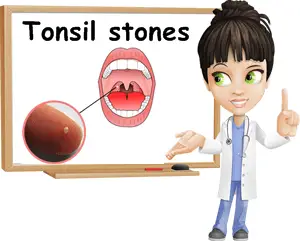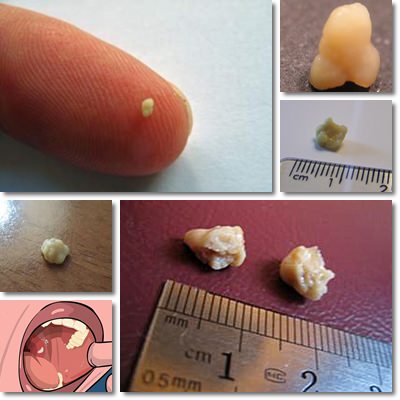Though not a pleasant discussion topic, tonsil stones, tonsilloliths or tonsil calculi are quite a frequent occurrence among adults of all ages. Tonsil stones are small, white, foul smelling calcified chunks or balls that appear in the back of the throat in the crevices of the tonsils, hence their name. While they do not pose any serious health risks, tonsilloliths are commonly associated with bad breath, frequent tonsil infections, swelling or difficulty swallowing.
Tonsil stones are generally small in size which is why most people do not even realize they have them until they cough one up. It so happens that many people spit out one or more tonsil stones after a strong sneeze or a coughing fit. The force of the sneeze, for example, may result in one of these so-called stones being dislodged from the crevice it is in and spit out. Unless they are either too big or too many, tonsil stones generally do not require medical treatment.

What are tonsil stones?
We all know what tonsils are: they are pink-colored glands located on the left and right sides of the back of the mouth. They are made of a special kind of tissue called lymphatic tissue and thus boast an important role in immunity, producing lymphocytes, a class of white blood cells. In other words, tonsils are a vital part of our immune system, a sort of production center which delivers white blood cells to the body in case of an infection and traps incoming bacteria.
How do tonsil stones form?
Our tonsils are also full of tiny crevices or pockets. And because the air we breathe in is almost never clean, bacteria, viruses or other particles that we breathe in get trapped in these crevices and cannot make their way to our lungs or other parts of our body. Dead cells, food particles and other kinds of debris also get stuck in there. In time, all of this accumulated material can become calcified, resulting in tonsil stones.
What are tonsil stones made of?
Calcified dead cells, tiny food particles, globs of mucus, bacteria, debris and minerals caught in the crevices of our tonsils. In time, they calcify, resulting in hard chunks or balls known as tonsil stones or tonsilloliths. The reason why tonsil stones are not considered an urgent medical problem is because they contain mainly calcium (carbonate), but also magnesium salts, phosphorus or ammonia.

How big are tonsil stones?
Tonsil stones can be barely visible, the size of a pea or peppercorn or larger. The larger the calcification, the more likely it is for it to cause discomfort and the easier to be removed.
What color are tonsil stones?
Generally, they are whiteish or a cream color and have a somewhat irregular shape. Many people mistake them for popcorn kernels stuck in the back of their throat.
Why do tonsil stones smell bad?
Halitosis, better known as bad breath, is a common symptom of tonsil stones. The smell tends to be more pungent in people with recurrent tonsil stones, larger or more than one or two tonsil stones. It has been suggested that tonsil stones attract bacteria which feeds on them, creating a foul smell. Also, tonsilloliths may also cause an increase in respiratory infections which adds to the bacteria buildup in the area and the bad mouth odour.
Signs and symptoms of tonsil stones
Tonsil stones are often asymptomatic. However, some people may experience one or more of the following signs and symptoms:
- Bad breath (halitosis).
- Difficulty and pain swallowing (food, fluids, saliva).
- Sore throat.
- Tonsil swelling.
- Metallic taste in the mouth.
- The feeling of a foreign object in the back of the throat.
- The sensation your throat is tightening or closing.
- A chocking sensation.
- Coughing fits, probably meant to help dislodge the tonsil stones and cough them up.
- Ear pain, ear infections and tonsillitis. People with recurrent tonsil infections are more prone to tonsil stones.
Nevertheless, many people discover they have tonsil stones by pure accident, during routine medical examinations. While some may have bothersome symptoms, others do not exhibit any sign of pain, discomfort or any other symptoms, despite having larger stones. A powerful sneeze or a fit of coughing may be enough to dislodge one or more stones from the tonsil pockets and expel them.
What is the best treatment for tonsil stones?
As mentioned at the beginning of the article, tonsil stones do not require medical treatment. Only if they are too large and interfere with swallowing, breathing and eating you may be advised to have them removed by your doctor. However, in the rare situation they get that big, you may end up coughing them up before your doctor gets a chance to take a look at them.
Here are several tips to help ease symptoms such as bad breath, dislodge tonsil stones and eliminate them naturally:
- Crisp vegetables. Eating crisp vegetables such as celery, carrots, cucumber or cabbage might help dislodge the tonsil stones from their place and make you cough them up.
- Removing them at home. Some people remove their tonsil stones using the tip of their tongue, swabs or picks. However, try not to insist if they do not come out easily.
- Gargling. Many people rely on gargling with warm water and salt to help improve symptoms and keep tonsils clean. Gargling with vinegar and warm water is believed to help dissolve the stones and kill viruses or bacteria on the tonsils.
- Propolis throat spray. A natural throat spray with propolis can help destroy bacteria and may help prevent their reappearance.
- Warm herbal teas. Warm herbal infusions made from lemon balm, chamomile, peppermint and other herbs with similar properties can help reduce swelling and discomfort and act as a local antiseptic, reducing bacteria numbers.
- Good oral hygiene. Brushing teeth frequently, using mouthwash and gargling contribute to good oral hygiene, help improve mouth odour and reduce bacteria numbers in the mouth as well as remove food particles that may be stuck in unpleasant areas of the mouth.
- Surgical removal or laser removal of both tonsils and tonsil stones are possible, but not recommended except for special cases where the person suffers from recurrent tonsil infections.
Common misconceptions regarding tonsil stones include:
- Dairy products cause tonsil stones. While eating dairy products does not cause tonsilloliths, certain foods (bread, for example) are easily stuck in the tonsil crevices and may create a buildup.
- Tonsil stones are popcorn kernels or peanut fragments stuck in the tonsil pockets or crevices (throat pearls or throat boogers).
- Once taken out, they do not reappear. Actually, most people have recurrent tonsilloliths. If the stones are small and you do not remove them manually, they may stay lodged in the tonsil crevices for years.
